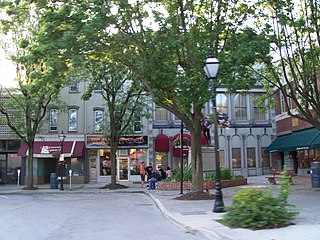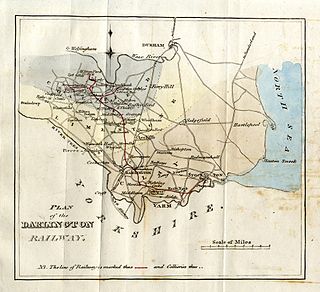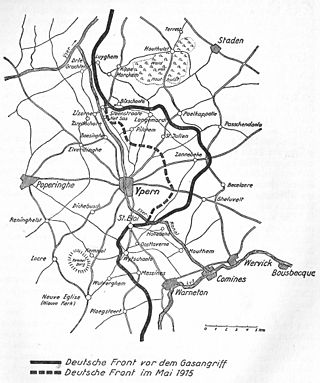
The Birth of a Nation, originally called The Clansman, is a 1915 American silent epic drama film directed by D. W. Griffith and starring Lillian Gish. The screenplay is adapted from Thomas Dixon Jr.'s 1905 novel and play The Clansman. Griffith co-wrote the screenplay with Frank E. Woods and produced the film with Harry Aitken.

The Dardanelles, also known as the Strait of Gallipoli and in Classical Antiquity as the Hellespont, is a narrow, natural strait and internationally significant waterway in northwestern Turkey that forms part of the continental boundary between Asia and Europe and separates Asian Turkey from European Turkey. Together with the Bosporus, the Dardanelles forms the Turkish Straits.

Hanover is a borough in York County, Pennsylvania, United States. The population was 16,429 at the 2020 census. Located 19 miles (31 km) southwest of York and 54 miles (87 km) north-northwest of Baltimore, Maryland, the town is situated in a productive agricultural region. It is named after the German city of Hanover and is a principal city of the York–Hanover metropolitan area.

The Black Watch, 3rd Battalion, Royal Regiment of Scotland is an infantry battalion of the Royal Regiment of Scotland. The regiment was created as part of the Childers Reforms in 1881, when the 42nd Regiment of Foot was amalgamated with the 73rd (Perthshire) Regiment of Foot. It was known as The Black Watch from 1881 to 1931 and The Black Watch from 1931 to 2006. Part of the Scottish Division for administrative purposes from 1967, it was the senior Highland regiment. It has been part of the Scottish, Welsh and Irish Division for administrative purposes since 2017.

Granville is a town on the eastern border of Washington County, New York, United States, abutting Rutland County, Vermont. It is part of the Glens Falls Metropolitan Statistical Area. The town population was 6,215 at the 2020 census.

The Stockton and Darlington Railway (S&DR) was a railway company that operated in north-east England from 1825 to 1863. The world's first public railway to use steam locomotives, its first line connected collieries near Shildon with Darlington and Stockton in County Durham, and was officially opened on 27 September 1825. The movement of coal to ships rapidly became a lucrative business, and the line was soon extended to a new port at Middlesbrough. While coal waggons were hauled by steam locomotives from the start, passengers were carried in coaches drawn by horses until carriages hauled by steam locomotives were introduced in 1833.

During the First World War, the Second Battle of Ypres was fought from 22 April – 25 May 1915 for control of the tactically important high ground to the east and south of the Flemish town of Ypres in western Belgium. The First Battle of Ypres had been fought the previous autumn. The Second Battle of Ypres was the first mass use by Germany of poison gas on the Western Front.

"The Road Not Taken" is a narrative poem by Robert Frost, first published in the August 1915 issue of the Atlantic Monthly, and later published as the first poem in the 1916 poetry collection, Mountain Interval. Its central theme is the divergence of paths, both literally and figuratively, although its interpretation is noted for being complex and potentially divergent.
The Association for the Study of African American Life and History (ASALH) is a learned society dedicated to the study and appreciation of African-American History. The association was founded in Chicago on September 9, 1915, during the National Half Century Exposition and Lincoln Jubilee, as the Association for the Study of Negro Life and History (ASNLH) by Carter G. Woodson, William B. Hartgrove, George Cleveland Hall, Alexander L. Jackson, and James E. Stamps, and incorporated in Washington, D.C., on October 2, 1915. The association is based in Washington, D.C. In 1973, ASNLH was renamed the Association for the Study of Afro-American Life and History.

Misty Fjords National Monument is a national monument and wilderness area administered by the U.S. Forest Service as part of the Tongass National Forest. Misty Fiords is about 40 miles (64 km) east of Ketchikan, Alaska, along the Inside Passage coast in extreme southeastern Alaska, comprising 2,294,343 acres (928,488 ha) of Tongass National Forest in Alaska's Panhandle. All but 151,832 acres (61,444 ha) are designated as wilderness.

The 53rd Street station is a local station on the BMT Fourth Avenue Line of the New York City Subway. Located at 53rd Street and Fourth Avenue in Sunset Park, Brooklyn, it is served by the R train at all times. The N train also stops here during late nights, and some rush-hour W trains stop here in the peak direction.

The Battle of Aubers was a British offensive on the Western Front on 9 May 1915 during the First World War. The battle was part of the British contribution to the Second Battle of Artois, a Franco-British offensive intended to exploit the German diversion of troops to the Eastern Front. The French Tenth Army was to attack the German 6th Army north of Arras and capture Vimy Ridge, preparatory to an advance on Cambrai and Douai. The British First Army, on the left (northern) flank of the Tenth Army, was to attack on the same day and widen the gap in the German defences expected to be made by the Tenth Army and to fix German troops north of La Bassée Canal.

Lambton is a neighbourhood in the city of Toronto, Ontario, Canada. It is situated on the east bank of the Humber River north and south of Dundas Street West. It is bounded on the north by Black Creek, on the east by Jane Street and on the south by St. Mark's Road. The area west of Gooch Avenue and south of Dundas Street West is also known as "Warren Park", the name of the housing sub-division built in the 1950s. The portion south of Dundas Street West is within the 'Lambton Baby Point' neighbourhood as defined by the City of Toronto.
The Royal East Kent Yeomanry was a British Army regiment formed in 1794. It saw action in the Second Boer War and the First World War.

The 58th Division was an infantry division created in 1915 as part of the massive expansion of the British Army during the First World War. It was a 2nd Line Territorial Force formation raised as a duplicate of the 56th Division. After training in Britain, the division joined the British Expeditionary Force (BEF) on the Western Front in 1917. It saw action at the battles of Arras and Passchedaele in 1917 and the German spring offensive in 1918. It then took part in the Battle of Amiens and the final Allied Hundred Days Offensive of the war. The division was recreated during the Second World War, as an imaginary deception formation.
The 64th Division was an infantry division of the British Army, raised during the Great War. The division was formed in late 1914 as a second-line Territorial Force formation which served on home defence duties throughout the war.
Maitland, originally called Garden City and sometimes misspelled Midland, is a ghost town in Lawrence County, South Dakota, United States. It was a mining community that boomed during the Black Hills Gold Rush, but was abandoned by about 1915.

Lake Arkona was a stage of the lake waters in the Huron-Erie-Ontario basin following the end of the Lake Maumee levels and before the Lake Whittlesey stages, named for Arkona, Ontario, about 50 miles (80 km) east of Sarnia.
Amphitorna trogoptera is a moth in the family Drepanidae. It was described by Walter Rothschild in 1915. It is found in West Irian in New Guinea.

The Highland Cyclist Battalion was a bicycle infantry battalion of the Territorial Force, part of the British Army. Formed as part of the Volunteer Force in 1860, it became a Volunteer Battalion of the Black Watch in 1881. In 1909 it became an independent unit and served in the United Kingdom throughout the First World War. In 1920 it was converted as part of the Highland Divisional Signals.














